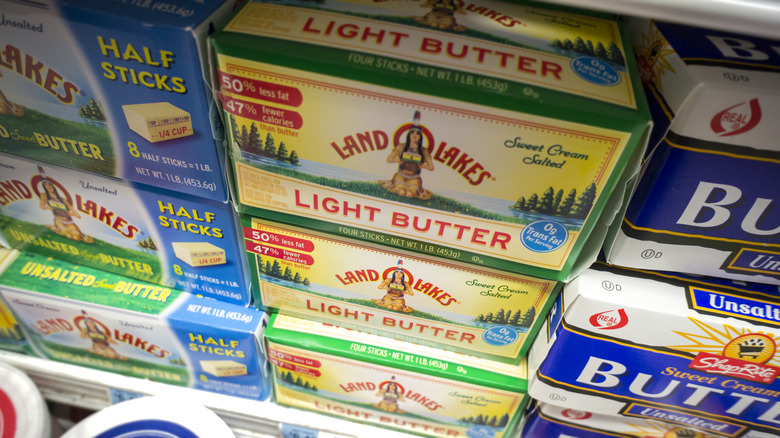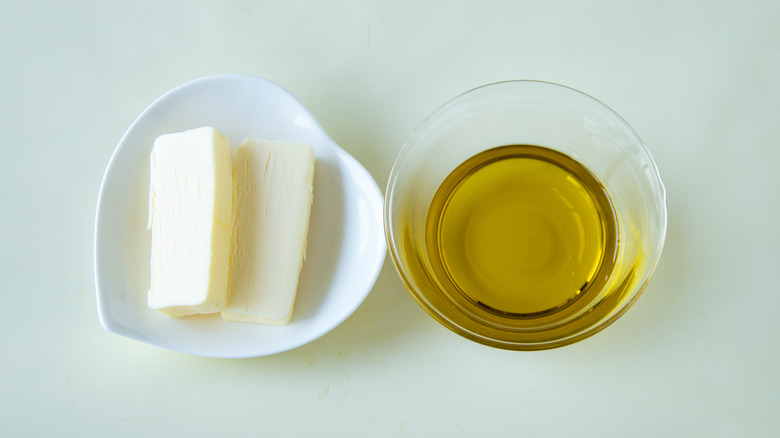Why Low-Fat Butter Is Seriously Ruining Your Baked Goods
Do your cookies consistently turn out crummy? According Yami Mercado, pastry chef for the Chicago Athletic Association's rooftop restaurant, Cindy's, low-fat butter could be the culprit. "In baking, fat is essential — it's what gives pastries their flake, tenderness, and richness," Mercado told The Takeout. "Low-fat or spreadable butters often contain way more water, which throws off the balance in recipes and can lead to tough textures or soggy bottoms."
If you really want to cut back, look for recipes that call for less butter instead of using a low-fat alternative. Your baked goods might still come out a little tougher than normal, though. Fat keeps gluten from developing, so low-fat cakes and cookies often turn out tough and chewy due to the higher gluten content.
It's worth considering whether you really need that low-fat butter, anyway. Many people avoid butter for health reasons since butter, with its high saturated fat content, has traditionally been considered a nutritional no-no. Recently, researchers are questioning whether it's really all that bad. A 2016 meta-analysis found that butter consumption had "relatively small or neutral overall associations" with cardiovascular disease, diabetes, and mortality. Many nutritionists say that butter can be part of a healthy diet — as long as you eat it in moderation and balance it out with other nutritious foods.
What kind of butter should you use for baking?
If you can't use low-fat butter or the spreadable stuff, what kind of butter should you use? "For precision baking like croissants or puff pastry, you want high-fat, low-moisture butter," says Mercado. "I love using Plugrá — it's about 82% butterfat with only 18% water, which is ideal. You want to look for a fat content above 80% if you're baking anything that needs structure or layering."
Any regular, not-reduced-fat butter you'll find in the grocery store should meet that 80% fat requirement – it's the industry standard in the United States. Want something extra deluxe? Look for European-style butters like Plugrá. According to European Union standards, butter needs to have at least 82% fat.
"European-style" doesn't necessarily mean "European-made," though. Nowadays, the term is used to refer to fattier butters in general, regardless of where they come from. Some of the best European-style butters are made in the United States. Case and point: Mercado's favorite, Plugrá. Plugrá is an American brand, but the name references the butter's European inspiration. Plugrá comes from "plus gras," French for "more fat." If you can't find it in stores, look for high-fat options from brands like Vital Farms, Vermont Creamery, and Kerrygold. Amish butter tends to have more butterfat than the standard American stuff, too.
How can you make baked goods healthier without getting rid of fat?
Mercado doesn't recommend ditching fat, but she says that bakers can change recipes in other ways to help meet health goals. "Instead of cutting out fat completely — which can mess with texture — you can try swapping out other ingredients," she says. "Using almond flour adds protein and a little richness while cutting carbs. Coconut milk is a great dairy-free option that still has good fat content. You can also explore naturally lower-sugar dark chocolate or sugar-free baking chocolate if you're watching your sugar intake."
Sometimes, you might be able to swap one fat for another. If the recipe calls for melted butter, you might be able to swap it for a healthy oil like olive oil or avocado oil. Generally, you'll want to reduce the amount by a fourth. Which is to say, instead of 1 cup of melted butter, use ¾ cup of oil. (For 2 cups of butter, use 1½ cups oil.) Never substitute oil for butter in a recipe that requires creaming ingredients, though. It'll mess up the texture.
Remember: Fat, gluten, and sugar are typically there for a reason. Nixing them entirely can and will come with consequences, so try to find replacements instead. "It's all about smart swaps," says Mercado. "Not cutting corners."


